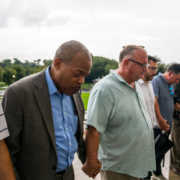How to Help Someone without Rescuing Them

One of the hardest things to navigate is helping someone in a healthy way, without rescuing them in an unhealthy way. We don’t want to interfere with God’s process of sowing and reaping in their lives. (Here’s my previous post with 3 reasons why.)
Sometimes it feels like watching a train wreck in slow motion.
Compound that with, so often, people don’t want to change the lifestyle that’s causing the pain in their lives. They just want to be free from the pain.
It’s like someone banging their head on a brick wall. They want the headache to stop. But rather than being willing to stop banging their head on the brick wall, they’re looking for a helmet with more padding.
Giving Them Their Power Back
People in crisis often feel powerless. Like someone trapped on the third floor of a burning building, they want someone to pull up in a magic firetruck and rescue them from their pain.
True healthy help restores them as a powerful person who can make choices over their own life. Rather than swooping in with the magic firetruck, healthy help leads them to the fire escape and helps them navigate it.
But it’s their journey. We never take ownership away from them. Even when it’s painful to watch them move forward so slowly, and we could do it for them so much faster.
How to Help: Asking Questions not Making Statements
This is a brilliant 20-minute video by Danny Silk on how to really help someone with a problem. I highly recommend watching it.
So often it is more helpful to ask questions, rather than stating the obvious or just telling someone what to do to solve the immediate problem.
- What’s the problem? If they don’t acknowledge there’s a problem, you’re done. If this is a family relationship, this is often a strong indication that someone has interrupted God’s process of sowing and reaping.
- What are you going to do? At this point, often people won’t know. They feel powerless, like they can’t do anything. Their emotions are supercharged, and their rational brain is offline. But it’s important for you to ask this question. It clearly defines who owns the problem, and whose it is to solve.
- What have you tried before? This is a great first step to help them slow down. Have you had this problem before? What have you done before that’s worked? Can you do that again? This helps them start thinking through the problem, helping their rational brain come back online.
- Would you like some suggestions? Advice requires permission. If they don’t want your advice, don’t give it. Jesus put it somewhat graphically, “Don’t throw your pearls before swine.” (Matthew 7:6)
- Have you tried…? Don’t say, “You should read this book.” Instead ask, “Have you read this book?” You are restoring them as a powerful person who can choose what they want to do to solve this problem.
- What are you going to do? The most empowering question in the universe. Keep coming back to this one.
The Mastermind Process
In writer’s groups I’ve been in, we have a process called “mastermind.” It’s an absolutely genius way to help someone get unstuck. I’ve seen people who were stuck on something for months (or years!) get unstuck in 10-15 minutes. It works like this.
The person with the problem states it, and we ask clarifying questions to make sure we understand. Then comes the fun part.
For the next five minutes, group members give recommendations. The person with the problem is not allowed to talk during this. They just write all the recommendations down in a list.
Then the person with the problem chooses three things off that list they are going to do in the next 30 days. No explaining why they chose certain suggestions and not others. No judgments, no apologies, no commentary. Just choices.
People come into this process scared because they don’t know what to do. But they come out of it energized and excited. What was an overwhelming and vexing problem just a few minutes ago is now solvable. They have a list. They have a plan. They have support.
And most importantly, they have ownership. The beauty of the mastermind process is that, while it never solves anyone’s problem for them, it empowers them to solve their problem.
There are two key factors that make this process work.
(1) The person owns the problem. No one tells them, “Hey, I noticed you have a problem on your blog. Let me tell you how to fix that.” They decided it was a problem. And they decided they needed help fixing it.
(2) The person owns the solution. While the group process helps them think through possible solutions, they choose what they’re going to do and not do. No pressure to pick certain options over others. And nobody in the group gets their nose bent out of joint if the person didn’t pick their recommendation.
Your Turn
Have you been on either end of this? Did someone help guide you through a problem? Or did someone “rescue” you, leaving you to solve a bigger problem with higher stakes later in life? Tell us your story in the comments and please share if this would bless others.











Leave a Reply
Want to join the discussion?Feel free to contribute!